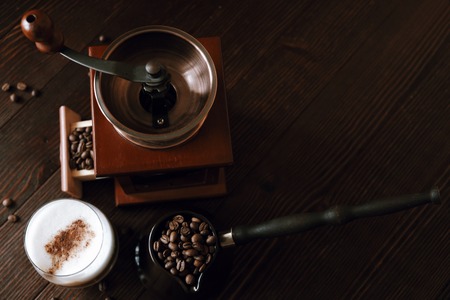1. Understanding British Coffee Preferences
When delving into the art of brewing the perfect cup, it’s essential to first understand what defines British coffee culture today. Traditionally, the UK was known for its love of tea, but over recent decades, coffee has firmly claimed its place in both homes and high streets. Across the country, preferences are evolving, influenced by both continental Europe and global trends. In general, British palates lean towards a balanced brew—smooth and not overly bitter—with many favouring milky coffees such as lattes, flat whites, and cappuccinos. Filter coffee and espresso-based drinks are also increasingly popular, especially in urban areas.
Arabica beans, prized for their nuanced flavours, gentle acidity, and natural sweetness, align well with these preferences. They lend themselves beautifully to lighter roasts and delicate preparations that highlight subtle tasting notes—ideal for those who appreciate complexity without overpowering bitterness. Robusta beans, on the other hand, offer a punchier profile with more body and a characteristic earthy bitterness. While less common in standalone form for British tastes, Robusta is frequently blended with Arabica to provide extra crema and strength, particularly in espresso blends enjoyed by those seeking a bolder flavour or an energising start to the day.
Preparation methods reflect this diversity: from cafetière (French press) brews in home kitchens to sophisticated espresso machines in coffee shops. Cold brew is gaining traction among younger generations seeking refreshing alternatives. Ultimately, whether crafting a comforting mug at home or ordering from a local café, understanding the interplay between bean type and brewing method is key to satisfying British tastes—where balance, smoothness, and approachability are always at the forefront.
2. Selecting Quality Arabica and Robusta Beans
Finding the perfect coffee beans is the first hands-on step towards crafting a brew that genuinely resonates with British tastes. Whether you favour the smoothness of Arabica or the punchy robustness of Robusta, sourcing high-quality, fresh beans is essential for a proper cup. Here’s a practical guide tailored for UK coffee enthusiasts looking to elevate their home brewing experience.
Sourcing Freshness: What to Look For
When shopping for beans, prioritise freshness above all. Seek out local roasteries or reputable shops where roast dates are clearly displayed. In Britain, specialty coffee shops often roast in small batches, allowing you to find beans roasted within the past two weeks—a critical window for peak flavour.
| What to Check | Why It Matters | British Tip |
|---|---|---|
| Roast Date | Ensures maximum flavour and aroma retention. | Aim for beans roasted within 14 days for daily brews. |
| Origin Information | Indicates flavour profile and quality transparency. | Look for clear details about region and farm on packaging. |
| Sustainability Badges | Supports ethical farming and environmental care. | Rainforest Alliance or Fairtrade marks are widely recognised in the UK. |
Choosing Between Arabica and Robusta for Local Palates
Arabica beans are celebrated for their delicate acidity and nuanced flavours—think floral, fruity, or nutty notes—making them popular among those who prefer a lighter, more sophisticated brew. Robusta, on the other hand, has a bolder, earthier taste with higher caffeine content. Many Britons appreciate a blend: Arabica’s elegance balanced by Robusta’s strength, ideal for the classic British flat white or an invigorating morning cafetière.
Key Considerations by Origin
| Origin | Tasting Notes | Best For |
|---|---|---|
| Ethiopia (Arabica) | Citrus, floral, tea-like body | Pourover, filter coffee fans |
| Brazil (Arabica) | Chocolatey, nutty, smooth body | Cafetière/French press & milk-based drinks |
| Vietnam (Robusta) | Earthy, strong, rich crema | Espresso lovers & blends needing extra kick |
| India (Robusta/Arabica Blend) | Spicy, full-bodied, robust finish | Lattes & traditional British-style coffees |
Sustainability and Ethical Sourcing Practices
The UK market increasingly values sustainable choices. When possible, opt for beans certified by Fairtrade or Rainforest Alliance. These labels guarantee not only fair compensation for farmers but also adherence to responsible environmental practices—aligning your daily brew with broader British values around ethics and sustainability.
![]()
3. Essential Gear for British Home Brewing
When it comes to brewing Arabica and Robusta beans at home, British coffee enthusiasts are particular about their gear. The right equipment not only enhances the flavour profile of your chosen beans but also complements the daily rituals that define UK coffee culture. Let’s explore the most reliable and widely used brewing tools found in British homes and why these methods have become staples.
Cafetières (French Press): The Quintessential Choice
The cafetière, or French press, stands as a beloved classic in Britain. Its straightforward design—just ground coffee, hot water, and a gentle plunge—makes it accessible even on a busy morning. This method is especially well-suited for showcasing the nuanced notes of Arabica beans, delivering a rich body and depth that appeals to those who appreciate a robust yet balanced cup. For many Brits, the cafetière is synonymous with leisurely weekend breakfasts and catch-ups with friends.
Filter Machines: Consistency Meets Convenience
Filter coffee machines remain a fixture in British kitchens, thanks to their ease of use and consistent results. Whether brewing for one or a crowd, these machines allow precise control over extraction time and temperature, which is crucial when switching between Arabica’s delicate flavours and Robusta’s bold character. The filtered brew is typically lighter than French press coffee, making it ideal for those who enjoy several cups throughout the day without feeling overwhelmed by intensity.
A Nod to Tradition: Moka Pots & Percolators
While less common than cafetières or filter machines, moka pots and percolators still hold a place in some British households, particularly among those seeking a stronger, espresso-like cup. These methods tend to highlight Robusta’s natural strength and bitterness, catering to drinkers who favour an energetic start to their mornings.
Why These Methods Resonate with British Routines
The popularity of cafetières and filter machines is deeply intertwined with British lifestyle habits—practicality, sociability, and an appreciation for quality. These devices offer flexibility for both solitary moments and social gatherings, reflecting the dual nature of UK coffee culture: personal comfort paired with hospitality. Moreover, they are durable investments, often passed down through generations or gifted during significant life events—a testament to their enduring role in crafting the perfect brew at home.
4. Step-by-Step Brewing Techniques
Achieving the perfect cup of coffee is as much about method as it is about quality beans. In the UK, where preferences range from robust morning brews to delicate afternoon cups, understanding the right approach for Arabica and Robusta makes all the difference. Below you’ll find practical, easy-to-follow instructions tailored for British tastes, with details on ratios, temperatures, and infusion times for popular brewing methods.
Choosing Your Brewing Method
The most common methods in Britain are cafetière (French press), filter (drip), and espresso machines. Each brings out different qualities in Arabica and Robusta beans. Here’s a quick overview:
| Method | Best for | Key Features |
|---|---|---|
| Cafetière (French Press) | Arabica & Robusta blends | Full-bodied, ideal for leisurely mornings |
| Filter (Drip) | Single-origin Arabica | Smoother, highlights nuanced flavours |
| Espresso Machine | Robusta-heavy or Italian-style blends | Intense, perfect for lattes or cappuccinos |
Coffee-to-Water Ratios
Getting your ratios right is crucial. The table below offers guidance specifically adapted for British preferences—strong but not overwhelming, balanced yet flavourful.
| Brew Method | Coffee Amount (per 250ml water) | Bean Suggestion |
|---|---|---|
| Cafetière | 16g (about 2 heaped tablespoons) | 50% Arabica / 50% Robusta blend |
| Filter (Drip) | 15g (about 2 level tablespoons) | 100% Arabica, medium roast |
| Espresso | 18g per double shot | 70% Arabica / 30% Robusta blend |
Step-by-Step Instructions: Cafetière (French Press)
- Add coarsely ground coffee to the cafetière based on your ratio.
- Heat water to 92–96°C – just off the boil.
- Pour water evenly over grounds; stir gently.
- Brew for 4 minutes. For a stronger cup (favoured by many Brits), extend to 5 minutes.
- Press down slowly and serve immediately.
Step-by-Step Instructions: Filter (Drip)
- Place medium-ground coffee in the filter paper.
- Brew with water at 90–94°C.
- Total infusion time should be about 3–4 minutes for a clean finish and bright acidity.
- Savour black or with a splash of milk—a classic British touch.
Step-by-Step Instructions: Espresso Machine
- Tamp finely ground coffee into your portafilter (see recommended dose above).
- Brew at 92–96°C with an extraction time of 25–30 seconds.
- Aim for a rich crema—a sign of a well-balanced blend suitable for flat whites or cappuccinos.
- Add steamed milk if desired to create popular UK café drinks.
Troubleshooting Tips for British Palates
- If your brew tastes too bitter, reduce infusion time or lower temperature slightly.
- If it’s weak or watery, use more coffee or lengthen steeping time by 30 seconds.
- Darker roasts and higher Robusta content often suit those who add milk or prefer a stronger cup—the norm in many UK households.
With these hands-on techniques and adjustments rooted in British preferences, you’re set to craft a brew that delights every palate—from Sunday brunches to weekday pick-me-ups.
5. Customising Your Brew: Traditional and Contemporary Twists
When it comes to brewing Arabica and Robusta for British palates, the final flourish often lies in how you personalise your cup. In the UK, coffee is more than just a caffeine fix—it’s an opportunity for ritual, comfort, and creativity. Here’s how to infuse your brew with a classic British touch while experimenting with local flavours.
Adding Milk: The Quintessential British Move
Milk is central to many British coffee rituals. For a traditional approach, add a splash of semi-skimmed or whole milk to mellow out the stronger notes of Robusta or round off the acidity in Arabica. If you prefer plant-based options, oat milk has become a local favourite for its creamy texture and subtle sweetness, blending beautifully with both bean varieties.
Sugar and Sweeteners: Finding the Balance
While some purists take their coffee black, adding sugar remains a widespread custom—just a teaspoon can soften bitterness without overpowering the beans’ character. Demerara or muscovado sugars are excellent choices if you want a richer molasses note. For those seeking alternatives, honey from English wildflowers brings nuanced sweetness and supports local beekeepers.
Creative Variations Using Local Ingredients
Give your daily cup a twist by exploring regional additions. Try stirring in a pinch of ground nutmeg or cinnamon for warmth on chilly mornings, or add a few drops of vanilla extract for a nod to classic British desserts. For something uniquely local, infuse your brew with lavender or elderflower syrup—both popular in British gardens—for aromatic complexity. Even a dash of sea salt from Cornwall can enhance chocolatey notes in darker roasts.
Don’t overlook cold brew variations either: steep your grounds overnight with orange peel or crushed cardamom pods for a refreshing summer treat with British flair.
Personalisation as Ritual
The beauty of coffee culture in Britain lies in its adaptability—from strong builder’s brews to delicate café au lait styles. Experiment with ratios, temperatures, and add-ins until you find your signature cup. Whether you’re serving up at home or sharing with friends, these little tweaks ensure every mug feels distinctly yours—rooted in tradition yet open to new ideas.
6. Troubleshooting Common Brewing Issues
Even the most seasoned British coffee enthusiasts can encounter brewing hiccups when aiming for that perfect cup of Arabica or Robusta. Below, we break down frequent challenges and offer practical solutions tailored for the UK palate.
Over-Extraction: When Your Brew Tastes Bitter
If your morning cup feels harsh or overly bitter, you may be extracting too much from the grounds. This is often due to a grind that’s too fine, water that’s too hot, or an excessively long brew time.
Solution
- Grind Adjustment: Try a coarser grind—especially for French press or cafetière methods popular in Britain.
- Temperature Control: Use water just off the boil (around 92–96°C) rather than boiling hot to preserve delicate notes in Arabica and balance Robusta’s boldness.
- Brew Time: Shorten steeping times by 30 seconds to one minute and taste as you go.
Underwhelming Flavour: When Coffee Tastes Weak or Flat
A cup lacking body or flavour can often be traced back to under-extraction or incorrect proportions—common issues when experimenting with different beans or new gadgets.
Solution
- Coffee-to-Water Ratio: For most British tastes, start with a ratio of 1:15 (one part coffee to fifteen parts water) and adjust to preference.
- Finer Grind: If using a percolator or AeroPress, use a slightly finer grind to increase extraction.
- Increase Brew Time: Let the grounds steep longer if you’re using a cafetière, but not so long as to risk bitterness.
Inconsistent Results: Chasing Consistency in Every Cup
If your brews vary wildly from day to day, it’s often down to inconsistent measurements, grind size, or water quality—a particular concern in regions with hard water across the UK.
Solution
- Weigh Ingredients: Use kitchen scales to measure coffee and water accurately every time—precision is key.
- Consistent Grind: Invest in a burr grinder for uniform particles; blade grinders can lead to unpredictable flavours.
- Mind Your Water: Consider filtered water if you live in a hard-water area like London or Manchester; minerals can affect both taste and equipment longevity.
Handy Tips for the British Brew Enthusiast
- Keep your kit clean—limescale build-up can wreak havoc on flavour.
- Taste and tweak—don’t be afraid to adjust variables one at a time until you find your sweet spot.
- If all else fails, join a local coffee tasting group or café workshop; sharing tips with fellow Brits can fast-track your journey towards the perfect home brew.
Solve these common stumbling blocks, and youll be well on your way to brewing Arabica and Robusta blends that truly satisfy British tastes—smooth, balanced, and reliably delicious from cup to cup.


